E-Archive
Articles
in Vol. 4 - July Issue - Year 2003
GIFA 2003 Process Automation in the Spotlight
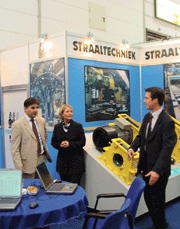
Stralltechniek displaying its new Wheel Technology
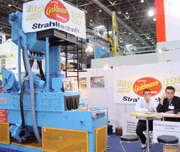
100 Years Goldmann Blasting Technology showing a Throughfeed Wheel Blasting Machine
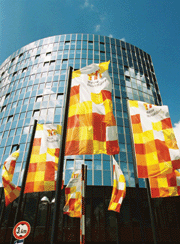
<font size=1>Foto: Tilmann</font>
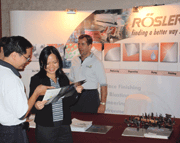
R
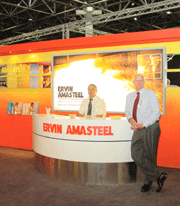
Heinz-Ullrich Kopal (right side) of Alfred Hermens who represents Ervin Amasteel for Cast Steel Shot and Grit Media
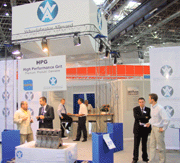
Wheelabrator Allevard manufactures High Performance Grit and Steel Shot
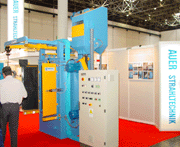
Auer Strahltechnik displaying a Wheel Blasting Machine
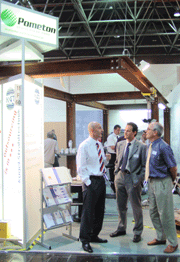
Ennio Torrigliani (left), Sales Manager, Fabio Cecchinato (center), Technician, Customer Service Dept., and Giovanni Gregorat (right), Sales Manager Pometon, the Italian Manufacturer of High and Medium Carbon Cast Steel Shot and Stainless Steel Shot, sharing a Booth with KST, a Job Shop for Blasting

MFG Strahlanlagen GmbH, a Manufacturer of Air Blasting and Peening Machines
Robots and casters work hand in hand
Casting has made major advancements over the last few years in terms of materials and manufacturing technology. Casting professionals from all over the world have traveled to GIFA 2003 in Düsseldorf this year to gather information on the state of the art and glean even more sophisticated manufacturing solutions for casting plants.
The extreme design flexibility casting offers, its commitment to metals recycling and a virtually closed-loop internal use of materials are a firm foundation for a competitive future. Today’s casting processes, most of which are highly automated, spell efficient and environmentally friendly production. Thanks to process automation and resource management, casting companies can secure their spot among the competition world-wide.
Innovations in process technology plus fine-tuned improvements to machinery and equipment for forming, melting and casting will help companies keep pace with the global market of tomorrow. The International Foundry Trade Fair, GIFA 2003 (16 to 21 June in Düsseldorf), offered small and medium-sized suppliers in particular a look at the latest trends and developments in manufacturing technology.
Exhibitors did showcase total and detailed solutions, raw materials and operating supplies for all casting processes on a very high technological level. Moreover, visitors discovered new techniques for die and core making as well as handling and cleaning. Exhibitors from pattern and die making did also present their portfolios. The latest developments in measurement and control technology plus environmental protection have been a further focal area of the event. Various services added the finishing touch to the exhibits.
While the use of information technology is very advanced in casting companies, increasingly sophisticated simulation and process automation methods still offer major potential for streamlining. These new/improved tools can offer successful solutions as early as the design or development phase. FEM calculations can already predict the mechanical properties of cast products with a high rate of accuracy. The configuration of the casting system and thermic process control can be based on 3D computer designs. There are current attempts to add further parameters to the calculations, which should further optimise process control.
Process simulation programs are being developed to perfect manufacturing organisation. 3D simulations, for instance, are helping to design robotic solutions for casting jobs that have not yet undergone automation. Handling equipment and industrial robots are already used for the manipulation and further processing of cores, moulds and cast parts. But for areas like cleaning, which require a high staff input, there have been few answers to date. Here, robots could make the workplace more appealing while helping to reduce production costs. New sensors and image processing systems could create jobs in which robots and humans work hand in hand. The concept is effective, as evidenced by solutions for the insertion of sleeves and removal of cast parts from pressure die casting machines. There are also handling devices that can automatically post-process the parts (sawing and trimming/deburring).
These and other automation solutions have been shown at GIFA 2003 alongside new methods of quality assurance that can reduce throughput times and lower costs.
Quality assurance cannot be restricted to optimised, secure manufacturing processes; it must also include the cast components themselves. The inspection of complex, heavy-duty cast parts using x-rays, which could previously only be performed manually by trained personnel, has been automated to the extent that the quality of cast wheels, axle supports, drive, clutch and pump housings can be monitored with handling devices and intelligent image processing while the products proceed through the machinery. After an inspection program for each type of part has been created, they can even be placed into the machinery in random order.
Similar to the last GIFA, developments in environmental protection and improvements to working conditions have been a central focus of the 2003 staging. Processes, procedures and the latest measurement and analysis methods for environmental protection were introduced. Aside from conservation of natural resources, the reduction of emissions and minimisation of residual matter has been stressed.
The 10th GIFA featured the world’s top manufacturers of foundry machinery and plant, No. 1 suppliers of casting materials and auxiliaries, as well as frontrunners in measurement and control and quality assurance systems production (including foundry chemistry and specialist engineering companies). This year’s show had around 780 exhibitors showcasing on an area just under 43,000 m2. One GIFA highlight was the WFO Technical Forum staged by Verein Deutscher Gießereifachleute (German Foundrymen’s Association - VDG) in harness with the World Foundrymen Organisation (WFO), which explored the full spectrum of state-of-the-art IT for foundries.
For further information about the 10th International Foundry Trade Fair refer to www.gifa.de


























